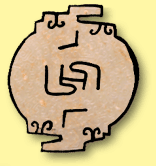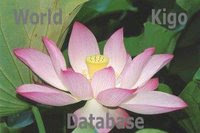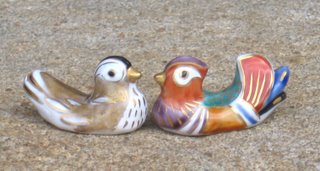:::::::::::::::::::::::::::::::::::::::::::::::::::::::::::::::::::::::::::::::::::::::::::::::::::::
© Article & illustrations © Joumana Medlej
The Jade and the Chinese
http://www.cedarseed.com/air/jade.html:::::::::::::::::::::::::::::::::::::::::::::::::::::::::::::::::::::::::::::::::::::::::::::::::::::
Double Dragon pendant --a stylized representation of two intertwined dragons.

The
phoenix (which is supposed to only land on stones of jade) and the
dragon were believed to be the life source of family clans, and so effigies of the two animal deities were carved in jade and worn as ornaments that symbolized a man's noble bearing. A saying derived from this practice: "The gentleman's morals are like jade." A delightful jade-vocabulary can be found in Chinese:
. Jade gold speech: Fine words.
. Jade wife: used to refer to your host's.
. Let your jade toes benignly approach: a courteous way of issuing an invitation.
. Jade Stalk: the male sexual organ.
. Jade Gate: the female sexual organ.
. To burn both jade and stone: complete devastation in war.
. Jade step: the imperial throne.
. Jade chariot: the imperial transport.
. To wear the jade: to serve in the Imperial bureaucracy.
Jade is also kown in China as the Dragon Stone, and interestingly, Chinese dragons are always represented with one or more water pearls.
In the Chinese Empire jade was considered the most noble of all gems; to the extent that it was simply designated under the name yü, "precious stone". Yü means "treasure" in Chinese the way "gold" means "wealth" in English. According to myth, the stone was born during a storm, and for this reason every home had jade in its foundations to keep lightning at bay. According to another myth, the stone was crystallized moonlight that came from the holy mountains. It was naturally the royal stone, and believed to be the incarnation of the cosmic principle. As such, it was said to possess the five essential virtues of Chinese philosophy: compassion, modesty, courage, justice and wisdom - but it was also credited with benevolence, knowledge, righteousness, virtuousness, purity, endurance, ingenuousness, morality and music.
A disciple of Confucius once asked him why men valued jade more than serpentine. "Is it because jade is scarce and serpentine is abundant?" Confucius replied:
"It is not, but it is because men of olden days regarded it as a symbol of the virtues. Its gentle, smooth, glossy appearance suggests charity of heart; its fine close texture and hardness suggests wisdom; it is firm and yet does not wound, suggesting duty to one's neighbor; it hangs down as though sinking, suggesting ceremony; struck, it gives a clear note, long drawn out, dying gradually away and suggesting music; its flaws do not hide its excellences, nor do its excellences hide its flaws, suggesting loyalty; it gains our confidence, suggesting truth; its spirituality is like the bright rainbow, suggesting the heavens above; its energy is manifested in hill and stream, suggesting the earth below; as articles of regalia it suggests the exemplification of that than which there is nothing in the world of equal value, and thereby is Tao itself."As a tribute to its value, the classics of Chinese philosophy suggested the creation of a special ministry to manage the use of the stone.
Many elements of the Chinese language are connected to jade. The concept of "peace" and "friendship" is written "jade-silk" (yu-po) because a long time ago these two materials were used together during worship and diplomatic meetings. We can also note that the earliest character for magician (wu) represents pi discs, perhaps because they were the only ones entitled to perform rituals.
As for "
ritual", it is written "
to serve the gods with jade". Indeed, six ritual jade stones were used as offerings to the six directions in nature cults and funerary rites. The Liji or Book of Rites, compiled around 300 BC, states: "If a ruler perfectly observes the rites of the state, white jade will appear in the valley". The specifics of the sacrifice are also found in the Liji:
"To give grace to the sky, one needs a sky-blue pi, to the earth a yellow t'sung, to the east a green kuei, to the south a red ch'ang, to the west a white hu, to the north a black huang".
Bells and chimes used during ritual were also made of jade, for the clear tone it gives off when struck was said to banish evil. Tales circulated of magical varieties of jade: one that stayed warm in winter and cool in summer; "red fire jade" that gave off light and heat; and even one that glowed in the dark.
Although jade could not prevent death, it was believed that it could help preserve a body, and the above amulets were used to this end: a pi was placed under the deceased1s back, a t'sung on his stomach, a huang at his head, a ch'ang at his feet, a kuei at his left and a hu at his right. "If you place gold and jade in the nine orifices of a corpse, the latter will be preserved from putrefaction", wrote Ko Hung.
Jade was used for many other magical purposes; for instance jade bowls would be used in meals so that the energy of the stone would permeate the food. It was worn on the fist or around the neck; merchants and advisors of the Empire held it in their hand for advice during negociations. The black variety sculpted as a disk was used to invoke the dead.
Jade also brought rain, scared away demons and poisonous animals, brought honor and victory, quenched the thirst, and insured longevity if carved in the shape of a stork or bat. Jade liquor would even be prepared by mixing in a copper bowl jade, rice and dew, that were then boiled and filtered; this drink was supposed to purify the blood and help one bear heat, cold and hunger. In some regions of China, jade bracelets are still believed to protect from rheumatism.
© Joumana Medlej
.................................................................................
hisui 翡翠(ひすい) jade
ジェード【jade】
mutton-fat jade
Hetian JadeHetian Nephrite is mined in the high altitude Kunlun Mountains (4500 m) in the Xinjiang Uygur autonomous region of north-western China, near the Mongolian and Russian boarder. Hetian Nephrite is divided into two categories: 'Mountain Nephrite' and 'Seed Nephrite,' with the Seed Nephrite being more desirable. Varieties of Seed Nephrite are: black jade, blue-white jade, green jade, mutton-fat Jade, tang jade, white jade, and yellow jade. Mutton-Fat Jade is considered to finest with a 'greasy' delicate texture and bright color. Chinese Hetian nephrite is nearing depletion due to over-mining, and as such it has become very valuble.
Chinese Jade Classification
source : www.allaboutgemstones.com :::::::::::::::::::::::::::::::::::::::::::::::::::::::::::::::::::::::::::::::::::::::::::::::::::::. Daruma from Agate and Jade (menoo to hisui) Daruma Museum, Japan :::::::::::::::::::::::::::::::::::::::::::::::::::::::::::::::::::::::::::::::::::::::::::::::::::::















